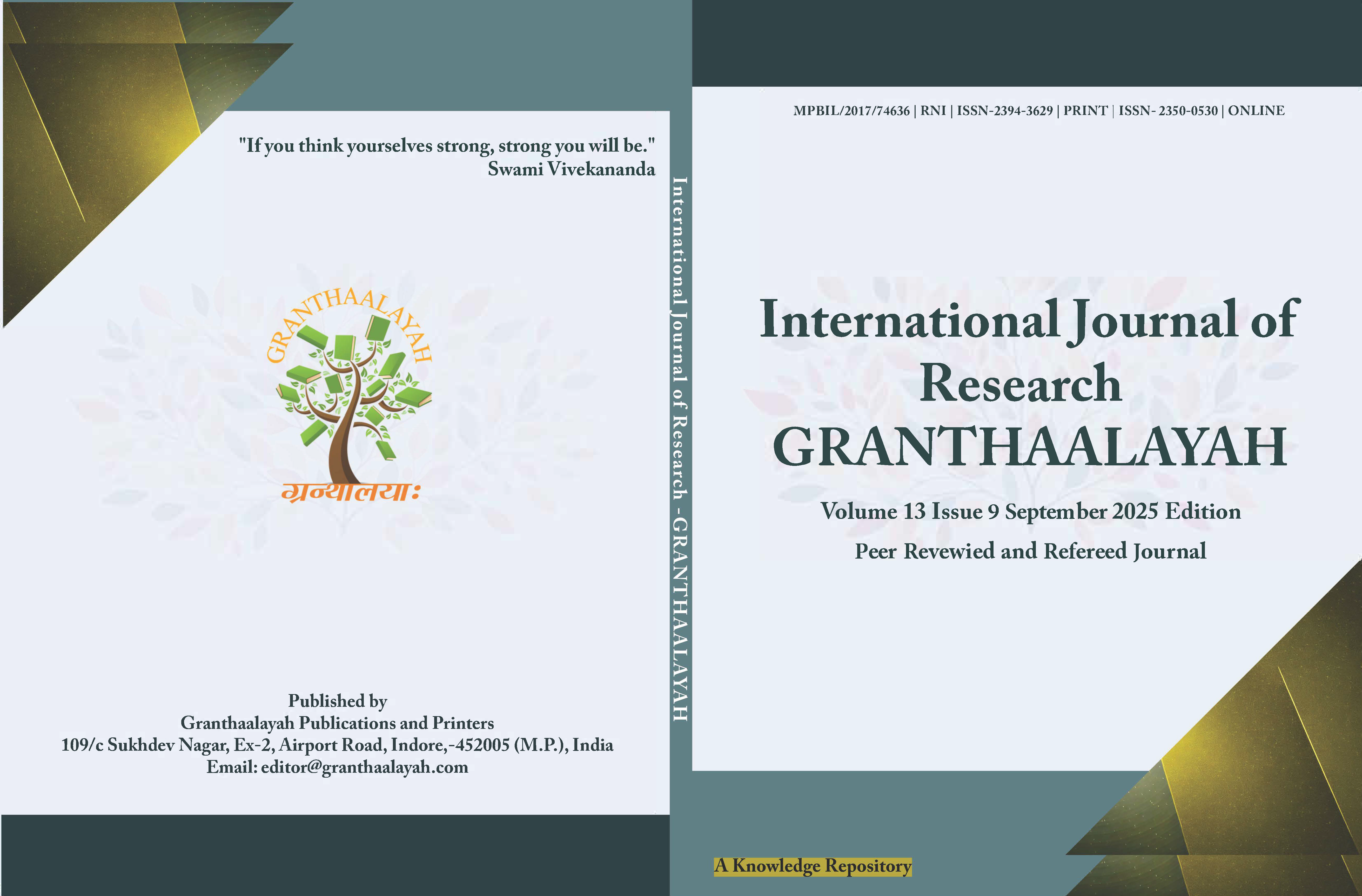CONTRIBUTION OF MIGRATION IN GROWTH OF MAJOR URBAN AGGLOMERATIONS IN INDIA
DOI:
https://doi.org/10.29121/granthaalayah.v13.i9.2025.6371Keywords:
Urban Agglomeration, Migration, Urban Growth, IndiaAbstract [English]
Universally, urban agglomeration symbolizes the rapid expansion of the modern urban world. In reshaping the demographic and spatial landscapes of urban agglomeration, migration plays a significant role. Most developing countries have evidence of a faster increase in urban agglomeration. India, like the most divergent regional divisional country, has different characteristics of urban centers. Where some cities developed in the early period, but some cities have developed in recent times. At the same time, metro cities have a unique way of growing and experiencing growth. This study investigates the nature of migration in the growth of major urban agglomerations in India, focusing on Mumbai, Delhi, Kolkata, Chennai, and Bangalore. Drawing on data from the Census of India 2011, the research analyzed decadal population growth, migration origin (rural vs. urban), inter- and intra-state migration patterns, duration of residence, and reasons for migration. The findings reveal that Delhi and Bangalore have experienced the highest growth rates due to inter-state migration driven by employment opportunities and economic liberalization. In contrast, Kolkata shows slower growth, rooted in longer-term, intra-state migration patterns. Notably, Chennai and Bangalore receive a higher proportion of urban-origin and skilled migrants, reflecting a shift toward knowledge-based urban economies. Meanwhile, Mumbai and Delhi continue to attract rural-origin populations, reinforcing their status as industrial and administrative hubs. This paper examines the critical role of migration in shaping India’s urban agglomerations and highlights the necessity for inclusive planning frameworks that address regional disparities and foster balanced urban growth.
Downloads
References
Abhishek, N., Jenamani, M., & Mahanty, B. (2017). Urban Growth in Indian Cities: Are the Driving Forces Really Changing? Habitat International, 69, 48–57. https://doi.org/10.1016/j.habitatint.2017.08.002 DOI: https://doi.org/10.1016/j.habitatint.2017.08.002
Angel, S., Sheppard, S., Civco, D. L., Buckley, R., Chabaeva, A., Gitlin, L., Kraley, A., Parent, J., & Perlin, M. (2005). The Dynamics of Global Urban Expansion. World Bank, Transport and Urban Development Department.
Benjamin, S. (2007). Lifestyling India’s Metros: The Elite’s Civic Reform. In Ensuring Public Accountability Through Community Action (179–208).
Bhagat, R. B. (2018). Urbanization in India: Trend, Pattern and Policy Issues. International Institute for Population Sciences.
Bhagat, R. B., & Mohanty, S. (2009). Emerging Pattern of Urbanization and the Contribution of Migration in Urban Growth in India. Asian Population Studies, 5(1), 5–20. https://doi.org/10.1080/17441730902790024 DOI: https://doi.org/10.1080/17441730902790024
Chandrasekhar, S., & Sharma, A. (2015). Urbanization and Spatial Patterns of Internal Migration in India. Spatial Demography, 3(2), 63–89. https://doi.org/10.1007/s40980-015-0006-0 DOI: https://doi.org/10.1007/s40980-015-0006-0
Chatterjee, A., Chattopadhyay, R. N., Chatterjee, A., & Chattopadhyay, R. N. (2020). Growth of Metropolises and Megacities with Focus on Global South. In Satellite Towns in Neo-Metropolitan Development in India: Lessons from Selected Cities (1–28). https://doi.org/10.1007/978-981-15-1502-6_1 DOI: https://doi.org/10.1007/978-981-15-1502-6_1
Chauvin, J. P., Glaeser, E., Ma, Y., & Tobio, K. (2017). What is Different About Urbanization in Rich and Poor Countries? Cities in Brazil, China, India and the United States. Journal of Urban Economics, 98, 17–49. https://doi.org/10.1016/j.jue.2016.05.003 DOI: https://doi.org/10.1016/j.jue.2016.05.003
Cohen, B. (2004). Urban Growth in Developing Countries: A Review of Current Trends and a Caution Regarding Existing Forecasts. World Development, 32(1), 23–51. https://doi.org/10.1016/j.worlddev.2003.04.008 DOI: https://doi.org/10.1016/j.worlddev.2003.04.008
Datta, P. (2004). Push-pull Factors of Documented Migration from Bangladesh to West Bengal: A Perception Study.
Dowall, D. E., & Monkkonen, P. (2008). Urban Development and Land Markets in Chennai, India. International Real Estate Review, 11(2), 142–165. DOI: https://doi.org/10.53383/100101
Dupont, V. D. N. (2011). The Dream of Delhi as a Global City. International Journal of Urban and Regional Research, 35(3), 533–554. https://doi.org/10.1111/j.1468-2427.2010.01027.x DOI: https://doi.org/10.1111/j.1468-2427.2010.01027.x
Fang, C., & Yu, D. (2017). Urban Agglomeration: An Evolving Concept of an Emerging Phenomenon. Landscape and Urban Planning, 162, 126–136. https://doi.org/10.1016/j.landurbplan.2017.02.014 DOI: https://doi.org/10.1016/j.landurbplan.2017.02.014
Fuller, C. J., & Narasimhan, H. (2007). Information Technology Professionals and the New-Rich Middle Class in Chennai (Madras). Modern Asian Studies, 41(1), 121–150. https://doi.org/10.1017/S0026749X05002325 DOI: https://doi.org/10.1017/S0026749X05002325
Iyer, N. K., Kulkarni, S., & Raghavaswamy, V. (2007). Economy, Population and Urban Sprawl: A Comparative Study of Urban Agglomerations of Bangalore and Hyderabad, India Using Remote Sensing and GIS Techniques. PRIPODE Workshop on Urban Population, Development and Environment Dynamics in Developing Countries, 1–37.
Jedwab, R., & Vollrath, D. (2015). Urbanization Without Growth in Historical Perspective. Explorations in Economic History, 58, 1–21. https://doi.org/10.1016/j.eeh.2015.09.002 DOI: https://doi.org/10.1016/j.eeh.2015.09.002
Joseph, K. J. (2006). India: An IT Powerhouse of the South. In Information Technology, Innovation System and Trade Regime in Developing Countries: India and the ASEAN (20–52). Springer. DOI: https://doi.org/10.1057/9780230626331_2
Kundu, A. (2011). Trends and Processes of Urbanisation in India. IIED.
Lambregts, B., Kleibert, J., & Beerepoot, N. (2018). The Making of Mumbai as a global city: Investigating the Role of the Offshore Services Sector. In Global City Makers (124–150). Edward Elgar Publishing. https://doi.org/10.4337/9781785368950.00014 DOI: https://doi.org/10.4337/9781785368950.00014
Mathur, O. P. (2021). State of the Cities India. Institute of Social Sciences.
Munda, J., & Nagdeve, D. A. (2022). A Spatial Analysis of Migration and Marital Status in the state of Maharashtra, India. Indian Journal of Spatial Science, 13(3), 75–85.
Narayana, M. R. (2011). Globalization and Urban Economic Growth: Evidence for Bangalore, India. International Journal of Urban and Regional Research, 35(6), 1284–1301. https://doi.org/10.1111/j.1468-2427.2011.01016.x DOI: https://doi.org/10.1111/j.1468-2427.2011.01016.x
Parida, J. K. (2019). Rural-Urban Migration, Urbanization, and Wage Differentials in Urban India. In Internal Migration, Urbanization and Poverty in Asia: Dynamics and interrelationships (189–218). DOI: https://doi.org/10.1007/978-981-13-1537-4_8
Parthasarathy, B. (2004). India’s Silicon Valley or Silicon Valley’s India? Socially Embedding the Computer Software Industry in Bangalore. International Journal of Urban and Regional Research, 28(3), 664–685. https://doi.org/10.1111/j.0309-1317.2004.00542.x DOI: https://doi.org/10.1111/j.0309-1317.2004.00542.x
Rana, L., & Singh, R. (2024). Urban Sprawl Modelling and Commuting Pattern–Delhi Gurgaon Corridor: A Sustainable Growth. International Journal of Social Science and Economic Research, 9(7). DOI: https://doi.org/10.46609/IJSSER.2024.v09i07.011
Rode, P., Chandra, R., Kundu, A., Nayar, N., First, B., Sudhira, H. S., ... & Vaidya, H. (2008). Connecting Cities: India. In 9th World Congress of Metropolis, Sydney, Australia.
Roy, P., Basu, R., & Roy, S. (2022). A Socio-Economic Perspective of Intergenerational Educational Mobility: Experience in West Bengal. Journal of Quantitative Economics, 20(4), 903–929. https://doi.org/10.1007/s40953-022-00313-y DOI: https://doi.org/10.1007/s40953-022-00313-y
Seto, K. C., Parnell, S., & Elmqvist, T. (2013). A Global Outlook on Urbanization. In T. Elmqvist et al. (Eds.), Urbanization, Biodiversity and Ecosystem Services: Challenges and opportunities (1–12). Springer Netherlands. https://doi.org/10.1007/978-94-007-7088-1_1 DOI: https://doi.org/10.1007/978-94-007-7088-1_1
Shamshad, R. (2017). Bengaliness, Hindu Nationalism and Bangladeshi Migrants in West Bengal, India. Asian Ethnicity, 18(4), 433–451. https://doi.org/10.1080/14631369.2016.1175918 DOI: https://doi.org/10.1080/14631369.2016.1175918
Shekhar, S., & Shekhar, S. (2021). Urbanization in India. In Slum development in India: A Study of Slums in Kalaburagi (1–20). https://doi.org/10.1007/978-3-030-72292-0_1 DOI: https://doi.org/10.1007/978-3-030-72292-0_1
Singh, J., & Debadhikary, R. (2021). Migration in India: Its Prospects and Problems. Kk Publications.
Sreya, S. (2022). Remembering Displacement in the Making of Everyday Life in Kolkata: A Sociological Study. Litinfinite, 4(1), 91–100. DOI: https://doi.org/10.47365/litinfinite.4.1.2022.91-100
Sridhar, K. S., Reddy, A. V., & Srinath, P. (2013). Is it Push or Pull? Recent Evidence from Migration into Bangalore, India. Journal of International Migration and Integration, 14(2), 287–306. https://doi.org/10.1007/s12134-012-0241-9 DOI: https://doi.org/10.1007/s12134-012-0241-9
Strozza, S., Benassi, F., Ferrara, R., & Gallo, G. (2016). Recent Demographic Trends in the Major Italian Urban Agglomerations: The Role of Foreigners. Spatial Dem DOI: https://doi.org/10.1007/s40980-015-0012-2
Sujatha, M., Devi, M. S., Thulasimala, D., & Janaki, L. (2014). Socio-economic Impact on In-Migrant Labourers: A Case Study of Chennai City. Acta Geochimica, 1, 180–189.
Sundari, R., & Manoj, M. S. (2020). “Catch them young”: Role of Educational Institutions in Community Development—A Descriptive Study on the Perception of College Students in Chennai.
Todaro, M. P. (1969). A Model of Labor Migration and Urban Unemployment in Less Developed Countries. The American Economic Review, 59(1), 138–148. https://www.jstor.org/stable/1811100
Triandafyllidou, A., Moghadam, A., Kelly, M., & Şahin-Mencütek, Z. (2024). Migration and Cities: An Introduction. In Migration and Cities: Conceptual and Policy Advances (1–18). Springer International Publishing Cham. DOI: https://doi.org/10.1007/978-3-031-55680-7_1
Tumbe, C. (2018). India Moving: A History of Migration. Penguin Random House India Private Limited.
United Nations. (2019). World Urbanization Prospects 2018: Highlights. Department of Economic and Social Welfare, Population Division.
Van Dijk, M. P. (2003). Government Policies with Respect to an Information Technology Cluster in Bangalore, India. The European Journal of Development Research, 15, 93–108. https://doi.org/10.1080/09578810312331287495 DOI: https://doi.org/10.1080/09578810312331287495
Wang, F., Fan, W., Lin, X., Liu, J., & Ye, X. (2020). Does Population Mobility Contribute to Urbanization Convergence? Empirical Evidence from Three Major Urban Agglomerations in China. Sustainability, 12(2), 458. https://doi.org/10.3390/su12020458 DOI: https://doi.org/10.3390/su12020458
Zhang, X. Q. (2016). The Trends, Promises and Challenges of Urbanisation in the world. Habitat International, 54, 241–252. https://doi.org/10.1016/j.habitatint.2015.11.018 DOI: https://doi.org/10.1016/j.habitatint.2015.11.018
Published
How to Cite
Issue
Section
License
Copyright (c) 2025 Ajay Murmu, Jadab Munda, Manish Mamgai

This work is licensed under a Creative Commons Attribution 4.0 International License.
With the licence CC-BY, authors retain the copyright, allowing anyone to download, reuse, re-print, modify, distribute, and/or copy their contribution. The work must be properly attributed to its author.
It is not necessary to ask for further permission from the author or journal board.
This journal provides immediate open access to its content on the principle that making research freely available to the public supports a greater global exchange of knowledge.

























